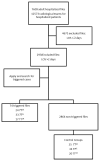The Use of Medical Imaging Request Forms as Trigger Tools to Detect Intra-Hospital Adverse Events: A Pilot Study
- PMID: 36415214
- PMCID: PMC9650978
- DOI: 10.5334/jbsr.2897
The Use of Medical Imaging Request Forms as Trigger Tools to Detect Intra-Hospital Adverse Events: A Pilot Study
Abstract
Aim: To evaluate the contribution of medical imaging request forms as trigger tools to detect patient adverse event (AE) occurring during hospitalization.
Material and methods: This is a retrospective study in a single institution. Between January and June 2019, the hospital information system (HIS) was fetched for request forms of radiological examinations performed for inpatients >48 hours after the admission date. The investigated request forms were: Doppler ultrasound of the upper limbs, Doppler ultrasound of the lower limbs, and the repetition of three consecutive requests of chest radiographs within 24 hrs, to detect upper or lower limb venous thrombosis, or AEs related to the respiratory system, respectively. Patients' medical charts and radiological examinations were evaluated to document the presence or absence of an AE. The frequencies of AEs in the three groups of trigger tools were compared to corresponding control groups, matched according to age, sex and length of stay.
Results: Among a total of 2798 hospital admissions during the study period, there were 74 files triggered by the three types of radiological request forms. There were 6/24 AE (25%) related to upper limb venous thrombosis, 4/33 (12.1%) AE related to lower limb venous thrombosis, and 6/17 (35.3%) AE related to the respiratory system. For all the trigger tools, the frequency of AE in the study groups was significantly higher than that in the control groups.
Conclusion: Medical imaging requests could be used as potential trigger tools to detect adverse events related to hospital stay.
Keywords: Doppler ultrasound; adverse events; chest radiographs; trigger tools.
Copyright: © 2022 The Author(s).
Conflict of interest statement
The authors have no competing interests to declare.
Figures
Similar articles
-
[Detection of adverse events using trigger tools in 2hospital units in Spain].J Healthc Qual Res. 2018 Jul-Aug;33(4):199-205. doi: 10.1016/j.jhqr.2018.05.003. Epub 2018 Aug 2. J Healthc Qual Res. 2018. PMID: 31610975 Spanish.
-
Characterisations of adverse events detected in a university hospital: a 4-year study using the Global Trigger Tool method.BMJ Open. 2014 May 28;4(5):e004879. doi: 10.1136/bmjopen-2014-004879. BMJ Open. 2014. PMID: 24871538 Free PMC article.
-
Adverse events identified by the global trigger tool at a university hospital: A retrospective medical record review.J Evid Based Med. 2019 May;12(2):91-97. doi: 10.1111/jebm.12329. Epub 2018 Dec 3. J Evid Based Med. 2019. PMID: 30511516
-
Variation in detected adverse events using trigger tools: A systematic review and meta-analysis.PLoS One. 2022 Sep 1;17(9):e0273800. doi: 10.1371/journal.pone.0273800. eCollection 2022. PLoS One. 2022. PMID: 36048863 Free PMC article.
-
Incidence of adverse events, preventability and mortality in gynaecological hospital admissions: A systematic review and meta-analysis.Aust N Z J Obstet Gynaecol. 2019 Apr;59(2):195-200. doi: 10.1111/ajo.12937. Epub 2019 Jan 20. Aust N Z J Obstet Gynaecol. 2019. PMID: 30663036
References
-
- Health Quality & Safety Commission New Zealand. The Global Trigger Tool – A Practical Implementation Guide for New Zealand District Health Boards; 2012.
-
- Amalberti R, Gremion C, Auroy Y, et al. Les systèmes de signalement des évènements indésirables en médecine. Etudes Résultats. 2007; 1: 584.
-
- La Prévention Médicale. Les systèmes de signalement [Internet]. 2020. Available from: https://www.prevention-medicale.org/formations-outils-et-methodes/method....
LinkOut - more resources
Full Text Sources


